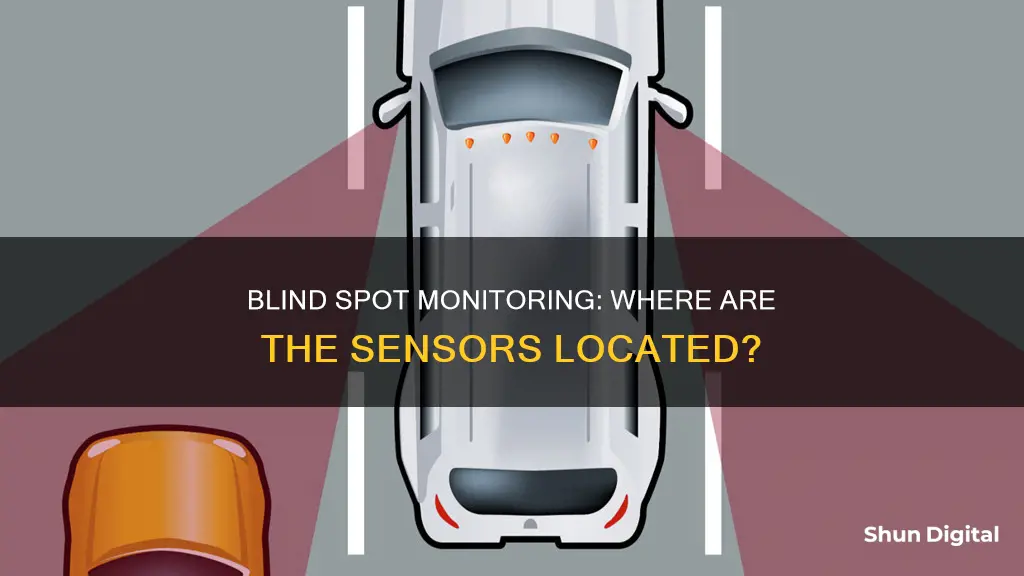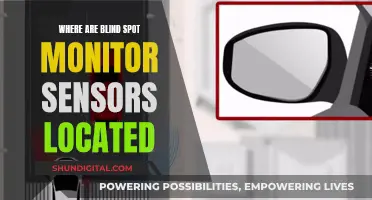
Blind spots are areas on either side of a car that a driver cannot see when looking into the rearview or side-view mirrors. All vehicles have blind spots, and they are the cause of around 9% of all reported vehicle crashes each year. Blind-spot monitoring (BSM) is an advanced driving assistance system designed to increase safety by alerting the driver to vehicles that may be in their blind spot. BSM uses radar or ultrasonic sensors located inside the left and right sides of the rear bumpers, as well as cameras in the side-view mirror housings, to detect vehicles in the blind spot area. Visual, audible, vibrating, or tactile warnings are then used to alert the driver. BSM is now a common feature in cars at every price point, and can also be installed as an aftermarket product.
| Characteristics | Values |
|---|---|
| What is it? | A vehicle-based sensor device that detects other vehicles located to the driver's side and rear |
| What does it do? | Warns drivers of vehicles that may have escaped visibility in the side-view mirrors |
| Types | Factory-installed, Aftermarket |
| Alert types | Visual, Audible, Vibrating, Tactile |
| When does it alert the driver? | When a passing vehicle approaches and potentially enters a blind spot on either side of the car |
| How does it alert the driver? | Visual indicator, illuminated icon, flashing light, audible warning, beeping tone, repeating chime, haptic alert (vibration through steering wheel or seat) |
| When is it operational? | Generally at speeds greater than 20 mph |
| How much does it cost? | $300 to $500 for an aftermarket system, plus at least $200 for installation |
What You'll Learn

Blind-spot monitoring systems: their function and features
Blind-spot monitoring systems are an essential safety feature in modern cars, designed to increase driver awareness and prevent accidents. These systems use sensors, cameras, and other technologies to detect vehicles or objects in a car's blind spots, providing drivers with visual, audible, vibrating, or tactile warnings.
Function and Features
Blind-spot monitoring systems are vehicle-based sensor devices that detect objects located in a car's blind spots, which are typically in the adjacent lanes on either side of the vehicle. These systems use a variety of technologies, such as radar, sonar, lidar, and cameras, to constantly monitor these blind spots and provide drivers with additional information.
One of the key features of blind-spot monitoring is the ability to provide drivers with real-time alerts when objects are detected in their blind spots. These alerts can take the form of visual indicators, such as flashing lights in the side-view mirror or gauge cluster, or audible warnings like beeping tones or chimes. Some systems even offer haptic feedback, such as vibrating steering wheels or seats, to ensure the driver is aware of potential hazards.
Another important feature of blind-spot monitoring systems is their ability to intervene and actively help the driver avoid collisions. More advanced systems can provide autonomous steering or braking input to prevent lane changes or manoeuvres that could result in an accident. These systems do not override the driver's control but rather provide subtle feedback to assist in decision-making.
Additionally, some newer systems utilise camera technology to provide a video image of the vehicle's side when the driver indicates their intention to change lanes. This feature enhances the driver's visibility and provides an extra layer of safety when navigating busy roads or tight spaces.
Blind-spot monitoring systems are now widely available across different vehicle segments, from subcompact cars to large trucks, and are offered by various automakers. They can be found as standard features or optional add-ons, depending on the manufacturer and vehicle model.
Benefits of Blind-Spot Monitoring Systems
Blind-spot monitoring systems offer several benefits that enhance safety and improve the driving experience:
- Increased Awareness: These systems provide drivers with additional information about their surroundings, reducing the risk of accidents caused by blind spots.
- Accident Prevention: By alerting drivers to potential hazards, blind-spot monitoring systems can help prevent lane-change crashes and reduce the impact of road accidents.
- Assists with Larger Vehicles: Blind-spot monitoring is especially useful for larger vehicles, such as SUVs or trucks, where visibility is more limited and blind spots are more prominent.
- Improved Response Time: With more accurate and timely information, drivers can react faster to potential dangers, enabling quicker braking or steering manoeuvres.
- Bundled Features: Blind-spot monitoring is often bundled with other safety features, such as rear cross-traffic alert, enhancing the overall safety package of the vehicle.
Replacing the LCD Monitor Cable on Your Asus Q502LA
You may want to see also

How to install a blind-spot monitoring system
Blind-spot monitoring systems are a great way to increase your driving awareness and safety. While some cars come with built-in systems, you can also install an aftermarket blind spot monitor.
Before you begin, it is important to note that blind-spot monitoring systems are vehicle-based sensor devices that detect other vehicles located to the driver's side and rear. Warnings can be visual, audible, vibrating, or tactile. While some systems are simple, others can be complex and difficult to install, especially those with cameras and screens. In such cases, it is recommended to seek professional help or opt for paid installation services.
If you choose to install the system yourself, here are the general steps to follow:
- Place a measuring tape parallel to your vehicle's wheels. Take out the calibration cloth and place it behind the vehicle, aligning it with the measuring tape at a 90-degree angle.
- Use a level to draw a straight line on the vehicle's rear bumper by standing it vertically against the vehicle and aligning it with the calibration cloth.
- Remove the rear bumper and, if necessary, the taillights.
- Clean the calibrating positions in the inner rear bumper with a cleaning cloth and rubbing alcohol.
- Place the two magnets included in the system on the lines you marked, one on the outside and one on the inside, attracting each other. Play around with the placement to find the optimal angle for the sensors.
- Mark the spot inside the bumper where the magnet rests.
- Apply adhesive to the sensors and stick them to the inside of the bumper.
- Mount the LED indicators inside the vehicle's cabin in a location that is easily visible without taking your eyes off the road.
- Adjust the volume of the indicators to ensure it is at a suitable level.
It is important to consult your specific vehicle's manual or repair guide for detailed instructions, as the installation process may vary depending on the make and model of your car.
Tips for Using Blind-Spot Monitoring Systems:
- Keep in mind that blind-spot monitoring systems are not a substitute for safe driving practices. Always use your turn signals, watch your mirrors, and look over your shoulders when changing lanes.
- Regularly clean the sensors and camera lenses to ensure they are free of obstructions like snow, ice, mud, dirt, or condensation, as this can impact the system's performance.
- Be aware of the limitations of the system. For example, it may not detect passing vehicles travelling at significantly higher speeds or smaller objects like motorcycles.
- Utilise the system's benefits, such as increased driving awareness and response time, to enhance your overall driving experience and safety.
The Monitor Conundrum: 27-Inch 1080p Display Worth Buying?
You may want to see also

The benefits of blind-spot monitoring
Blind-spot monitoring is a vehicle-based sensor device that detects other vehicles located to the driver's side and rear. It is designed to increase safety by alerting the driver to vehicles that may have escaped visibility in the side-view and rearview mirrors. The benefits of blind-spot monitoring include:
Safer Lane Changes
The biggest benefit of blind-spot monitoring is safer lane changes. Studies have shown that cars with blind-spot monitoring result in fewer lane-change accidents. This is because blind-spot monitoring uses sensors on the outside of the car to keep an eye on your blind spots and alerts you if a car is in your blind spot, making it more likely that you will avoid a collision.
Prevents Injuries
Fewer lane-change accidents mean fewer injuries. A study by the IIHS found a 23% drop in lane-change crashes with injuries in vehicles with blind-spot monitoring.
Prevents Damage
A prevented accident means a prevented trip to the shop for costly repairs to the body and mechanical components of your car. Blind-spot monitoring has been proven to reduce lane-change crashes, preventing costly damage.
Increases Driving Awareness
Blind-spot monitoring provides extra coverage, constantly viewing the spots you can't always track while driving. This is especially helpful for larger vehicles, as it can be difficult to see around them.
Enhances Driver Confidence
Knowing you have a system actively monitoring your blind spots can significantly boost your confidence behind the wheel. This is particularly valuable for new drivers or those who navigate heavy traffic conditions regularly.
Improves All-Around Awareness
While mirrors are crucial, they have limitations. Blind-spot monitoring complements your visual checks by providing a wider range of awareness. This is especially helpful on multi-lane highways or when maneuvering in tight spaces like parking lots.
Increases Safety for Vulnerable Road Users
Blind-spot monitoring can help detect smaller objects like cyclists and pedestrians, prompting drivers to exercise extra caution when turning or changing lanes. This can help create a safer environment for everyone on the road.
Potential Insurance Discounts
Some insurance companies may offer discounts to drivers whose cars are equipped with blind-spot monitoring. This is because blind-spot monitoring can demonstrably reduce the likelihood of accidents, leading to lower insurance costs for drivers and companies alike.
Monitors: Why You Should Invest in One Today
You may want to see also

Aftermarket blind-spot monitoring systems
Blind spots are areas on either side of a car that a driver cannot see when looking into the rearview or side-view mirrors. To compensate for human error, many car companies offer vehicles with built-in blind-spot monitoring systems (BSM), also known as blind-spot warnings, blind-spot detection, or blind-spot information systems.
If you own an older vehicle that's not equipped with certain types of technology, an aftermarket blind spot monitor is a perfect addition. Aftermarket blind spot monitoring systems are designed to keep you and your passengers safe by alerting you to potential hazards that you might not be able to see. They can also increase your driving awareness, assist drivers of larger vehicles, increase response time, and prevent crashes.
Aftermarket blind spot monitoring systems are not as common as factory-installed systems, but they are becoming more widely available as more companies enter the market. These companies offer custom-designed kits for a variety of vehicles, with features such as sonar, radar, and lidar technologies, as well as cameras inserted into side mirrors.
When choosing an aftermarket blind spot monitor, it's important to consider the type of sensor and indicator that best meets your needs. The sensor is the eyes of the system, using a variety of technologies to keep tabs on hazards. The indicator is equally important, as it alerts you when the sensor detects a hazard. Visual LED lights and alarms are common features, and you may also be able to control the volume of the indicator.
While professional installation is recommended, it is possible to install an aftermarket blind spot monitor yourself. The process typically involves calibrating the system, removing and cleaning certain parts, placing the sensors, and mounting the indicators inside the vehicle's cabin. However, it's important to consult your owner's manual or repair guide before attempting any installations or repairs.
Hooking Up Raspberry Pi to a VGA Monitor: A Step-by-Step Guide
You may want to see also

The history of blind-spot monitoring
Blind-spot monitoring is a vehicle-based sensor device that detects other vehicles located to the driver's side and rear. Warnings can be visual, audible, vibrating, or tactile. All vehicles have blind spots, which are areas on either side of a car that a driver cannot see when looking into the rearview or side-view mirrors. Blind spots are why a driver should always turn their head and check for cars before changing lanes.
The concept of blind-spot monitoring was first introduced by George Platzer in 1995. Platzer presented a paper to the Society of Automotive Engineers, suggesting that adjusting the side-view mirrors could lower the dangers of a car's blind spots. However, finding the right positioning can be challenging, and inexperienced drivers may put themselves in more danger by adjusting their mirrors incorrectly.
Platzer then presented the concept of blind-spot monitors to Ford Motor Company, claiming it to be "an elegant and relatively inexpensive solution" to the problem of blind spots. Ford was the first motor company to explore this idea.
The first implementation of a blind-spot detection system was by Volvo in 2001. They introduced the SCC concept car with a Blind Spot Information System (BLIS). However, the device was removed from production the same year and implemented in the Volvo XC90 SUV in 2003. The BLIS system used a camera to detect vehicles in the car's blind spots and had an alert system to notify the driver. Volvo was awarded the AutoCar Safety and Technology Award for this innovation.
Since then, blind-spot monitoring has become widely adopted by car manufacturers. In the mid-2000s, Volvo became the first to offer the technology in a production car. For the 2022 model year, nearly all new vehicles either included blind-spot monitoring as a standard feature or offered it as an option.
Today, most modern car companies integrate blind-spot monitoring into their models. Some of the pioneers in adopting this technology include Volvo, Ford, Mazda, and Mitsubishi. These manufacturers recognized the importance of understanding blind-spot dangers and took steps to implement this life-saving feature in their vehicles.
Blind-spot monitoring systems have evolved to become more advanced, using radar-based sensors that are weather-resistant and provide accurate results even in extreme weather conditions. While the basic framework remains the same, modern systems have added features such as GPS navigation, RCTA, and automated braking.
Aftermarket blind-spot monitoring systems are also available for older vehicles that may not have this technology built-in. These systems can be purchased and installed separately, providing drivers of older cars with the benefits of increased safety and awareness on the road.
Blind-spot monitoring has proven to be a valuable tool for both personal and professional drivers, reducing the risk of accidents and improving overall road safety. According to studies, the use of blind-spot detection systems can significantly reduce lane-change crashes and prevent thousands of road crashes each year.
Connecting a Monitor to Your ASUS: Easy Steps
You may want to see also
Frequently asked questions
Blind spot monitors use sensors, cameras, and sometimes radar or ultrasonic technology to detect vehicles in a driver's blind spot. The sensors are usually embedded in the side of the vehicle's rear bumper, while cameras are often side-mounted or inserted into the side mirrors.
Blind spot monitors alert the driver to vehicles that they cannot see in their side or rearview mirrors. This is done through visual, audible, vibrating, or tactile warnings.
Yes, there are two main types of blind spot monitoring systems. The first type simply provides an alert, while the second type pairs the alert with steering assistance.
Blind spot monitors are becoming increasingly common in cars and are now available at every price point. However, they are not standard in all vehicles and may be offered as a stand-alone option or as part of an options package.
Yes, you can install an aftermarket blind spot monitor in your car if it is not already equipped with one. These systems can be purchased as kits and are available from a variety of retailers.







